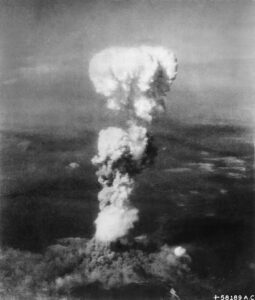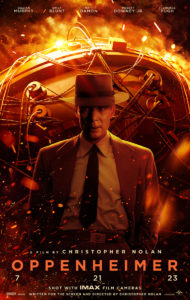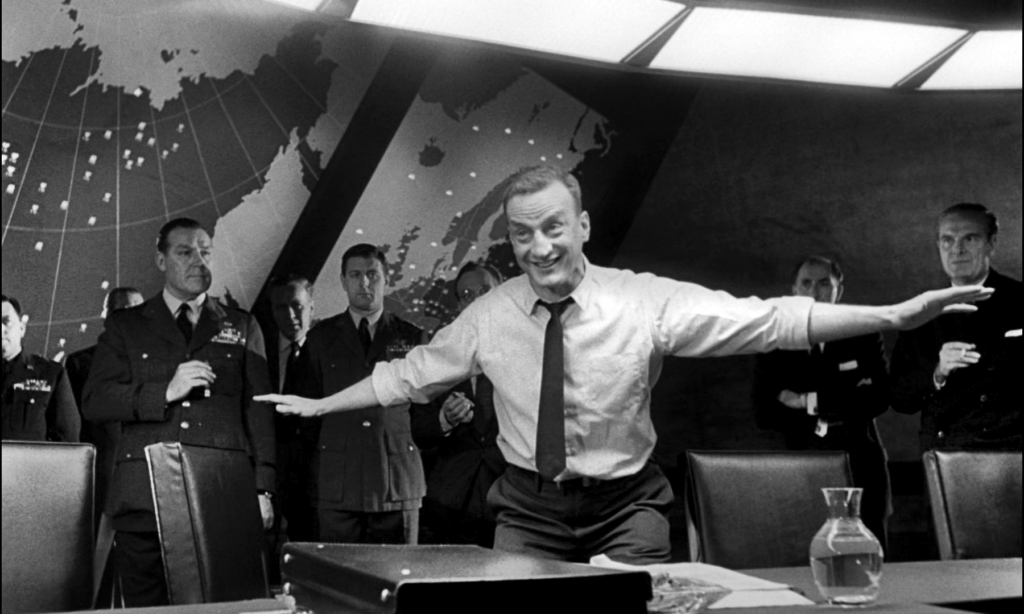by Jerry Moore

In a book published in 1914, author and social critic H.G. Wells said Britain must crush the German military and halt this nation’s imperialist intentions.
“We are fighting Germany. But we are fighting without any hatred of the German people. We do not intend to destroy either their freedom or their unity. But we have to destroy an evil system of government and the mental and material corruption that has got hold of the German imagination and taken possession of German life. We have to smash the Prussian imperialism as thoroughly as Germany in 1871 smashed the rotten imperialism of Napoleon III,” Wells wrote. “This is already the vastest war in history. It is war not of nations but of mankind. It is a war to exorcise a world madness and end an age.”
Wells’s book, titled “The War That Will End War,” consisted of previously published newspaper articles. In them, he promoted the justness of Britain’s cause and expressed his hopes that Allied victory in World War I would halt such aggression from occurring again.
This idealism is reflected in the notion of military deterrence. A peaceful nation may thwart any potential hostility by creating a military so powerful that any attacks against it would lead to annihilation.
The Allies were indeed victorious in World War I, but this failed to end aggression on the part of other nations. Two decades after the end of this war, Europe was plunged into another global conflict. And World War II proved even more devasting than its predecessor.
The goal of deterrence soon evolved to more than just possessing a powerful military. A weapon of unprecedented destructive power could keep enemies at bay if developed.
Under the direction of the U.S. Army, scientists created what many believed to be the ultimate weapon: an atomic bomb. One single device could destroy an entire city. All the research and production conducted on this effort was called the Manhattan Project.
When we dropped two such bombs on the Japanese cities of Hiroshima and Nagasaki in August 1945, Americans felt more secure than ever. We alone possessed the most destructive weapon ever devised, and we wouldn’t hesitate to use it to defend ourselves.

But just as the scientists who constructed the atomic bomb had predicted, the Soviet Union eventually caught up — now the Russians had the bomb as well. And in subsequent years, we both developed more powerful bombs — ones that could kill everyone on the planet if used to fight a nuclear war.
Released July 21, 2023, Christopher Nolan’s Oppenheimer examines this part of our nation’s history. The movie delves into the intellectual capabilities needed to figure out the complex physics and turn this into a weapon of mass destruction.
It also reflects the apprehension that many scientists had over pushing forward with such terrible devices. They righty feared an arms race would put too many bombs into inexperienced hands.
And the concept of deterrence was eventually reduced to one aspect of national security: thwarting another nation’s nuclear capabilities. So we needed hydrogen bombs to stop our adversaries from attacking us with their hydrogen bombs.
This raised grave concerns. Human or technological errors could trigger a nuclear exchange, one that would result in dire consequences for the entire world. Various film projects over the years have documented some of the problems and our resulting concerns.
The first movie to address the Manhattan Project and its aftermath was The Beginning or the End, released in 1947. It starred Brian Donleavy as Maj. Gen. Leslie Groves, Hume Cronyn as J. Robert Oppenheimer and Art Baker as President Harry Truman.

Those at MGM behind the film initially wanted to relate the facts behind the atomic bombings, particularly from the perspectives of the scientists involved. But government representatives exerted considerable influence on the film’s direction, and it ended up repeating some of the questionable assertions made for using atomic bombs against Japan. The film did poorly at the box office and has largely been forgotten.
Another movie, 1952’s Above and Beyond, focused on the man who piloted the B-29 that dropped the bomb on Hiroshima. Lt. Col. Paul Tibbets called his crew’s plane the Enola Gay, named after his mother. Above and Beyond starred Robert Taylor as Tibbets; Eleanor Parker as his wife, Lucy; and James Whitmore as security officer Maj. Bill Uanna.
The film centers on Tibbets’s selection for this top secret mission as well as his training for the assignment. It received favorable reviews and was nominated for two Academy Awards (Best Original Motion Picture Story and Best Scoring of a Dramatic Picture).
It would be nearly four decades before Hollywood once again broached the work conducted for the Manhattan Project. Distributed by Paramount Pictures, Paul Newman (Groves) and Dwight Schultz (Oppenheimer) starred in 1989’s Fat Man and Little Boy. The title refers to the names given to the two “gadgets” dropped on Japan.
Fat Man and Little Boy focuses on the work done at Los Alamos National Laboratory near Santa Fe, New Mexico. Like Oppenheimer, it chronicled the clashes between Groves and the scientists over the need for secrecy versus their desire for broad collaboration. It also reflected the concerns that participants had over how their research would be employed. The movie received mixed reviews.
Two films released in 1964 examined the scenario of a potential nuclear war resulting from errors. While they were similar in some respects, they approached this issue in starkly different ways.

Fail Safe starred Henry Fonda, Walther Matthau and Larry Hagman. U.S. Air Force bomber crews are holding at their “fail safe” point on the outskirts of the Soviet Union. A faulty computer system mistakenly orders one group into Russia to attack, and the race is on to either recall all the planes or destroy them before they deliver their bombs and ignite retaliation.
Fonda portrays the U.S. president; much of the drama of the movie is seen through the tense discussions between the president and the Soviet premier. Buck, Hagman’s character, provides the English translation for the president during the conversations. Matthau portrays a political scientist who advises the president to launch a full-scale attack against Russia to crush the Soviet Union once and for all.
Released by Columbia Pictures, Fail Safe was well received. It invited viewers to ponder the wisdom of having so many nuclear weapons given everything that could go wrong.
Another film in this vein made its point in an entirely different manner. Also released by Columbia Pictures, Dr. Strangelove or: How I Learned to Stop Worrying and Love the Bomb showcased satire at its finest.
British actor and comedian Peter Sellers played three roles in the dark comedy: U.S. President Merkin Muffley; Group Capt. Lionel Mandrake, an exchange officer with the British Royal Air Force; and German scientist Dr. Strangelove, who is now working on nuclear weaponry with the Americans. Other cast members include George C. Scott as Gen. Buck Turgidson, chairman of the Joint Chiefs of Staff; Sterling Hayden as Brig. Gen. Jack D. Ripper (it took me many years to finally recognize the irony of this character’s name); and Slim Pickens as Maj. T.J. “King” Kong, pilot of a B-52. Dr. Strangelove also features James Earl Jones in his film debut.
The movie opens with military officials becoming aware that a group of Strategic Air Command bombers has been ordered to bomb Russia. But this plan is supposed to be implemented only when the United States has been attacked and the normal chain of command has been disrupted, allowing a lower echelon officer to take charge.
Muffley convenes these officials in the War Room to determine what happened and how to reverse course. They discover that Ripper, commanding officer at Burpelson Air Force Base, has had quite enough of the Soviet Union. So he dispatched his boys into Russia to begin a nuclear war, and the president should send the rest of SAC in after them to avoid our being wiped out by the Soviet response.
Ripper has come to believe that the widening practice of putting fluoride into municipal drinking water systems is an ingenious communist plot to weaken our bodies. (Hard to believe, this idea was actually promoted by members of the John Birch Society!) Just like Fail Safe, military leaders need to figure out how to recall or shoot down the planes.

Much to the chagrin of Turgidson, Muffley has invited Soviet Ambassador Alexei de Sadeski into the War Room so the two countries can coordinate their efforts to prevent an attack. To his horror, de Sadeski learns that Soviet Premier Dimitri Kissov has already put a Doomsday Machine into play; this device will automatically trigger a nuclear response to any attack. He said this proved a more cost-effective way of providing for defense because the Soviet Union could keep up with “the arms race, the space race and the peace race.”
Directed by Stanley Kubrick, the film succeeds because it parodies not the horror of nuclear war but the warped Cold War mindset that led to the massive buildup of our hydrogen bomb stockpile. Kubrick was nominated for the Academy Award for Best Director, and Sellers was nominated for the Academy Award for Best Actor. Dr. Strangelove has long been ranked as one of the best satires ever made.
Some film projects over the past several decades have dramatized what a nuclear war would look like.
The War Game, released in 1966, was originally scheduled to be aired on the BBC. It was a semi-fictionalized documentary showing the effects of a nuclear attack on Britain. But government authorities and BBC representatives deemed it too graphic to broadcast publicly.
It was released as a movie in London before being shown internationally. It was praised for the brutal yet frank way it depicted a nuclear catastrophe.
The War Game won an Academy Award for Best Documentary Feature. The BBC eventually aired it in 1985.
One of the most effective film projects to depict the horrors of nuclear war was 1983’s The Day After, broadcast on ABC. The three-hour movie reflected the contentious relations between the Soviet Union and the United States.
The fictional storyline was brilliant. The film centered on the communities of Kansas City, Missouri, and Lawrence, Kansas.
Scenes showed America’s Heartland at its most picturesque. Who in the world would dream of destroying such a place?
And therein lies the dilemma. Resting among the rural shops, picket fences and farm fields of this region are about 150 Minuteman missiles prepared to launch at a moment’s notice.
When hostilities between the Soviet Union and United States overheat, residents of these two communities stand helpless as they watch all the missiles take off toward their targets. They know that very soon, they’ll be struck by warheads now coming their way.
Scenes of the nuclear exchange are incredibly shocking. The film shows people being vaporized, buildings obliterated and lives thrown into turmoil. The movie then deals with how individuals of these two communities try to regain some sense of order in the midst of all this death and destruction.
About 100 million Americans watched The Day After when first aired — an extraordinary number for a made-for-TV movie. The disturbing graphics traumatized many people; the film had a sobering effect on many of those who saw it and raised valid questions about U.S. foreign policy toward the Soviet Union.

Nuclear weaponry and the potential for a war have both fascinated and frightened us for decades. These film projects have compelled us to examine how we got here and where we’re going.
Yet despite highlighting the insanity of possessing these bombs, we still have them. We can’t seem to back away from the abyss of annihilation.
A documentary titled Race for the Superbomb, broadcast on PBS in 1999, chronicles the extensive challenges scientists had to overcome to create the hydrogen bomb (also called the Super). The film also details the fears many people expressed over a weapon that could destroy all life in Earth.
The final lines of the documentary sum up our dilemma: “Long after the collapse of the Soviet Empire, the United States and Russia continue to maintain several thousand nuclear warheads on constant alert. Getting rid of the Super, it seemed, was even harder than building it.”

